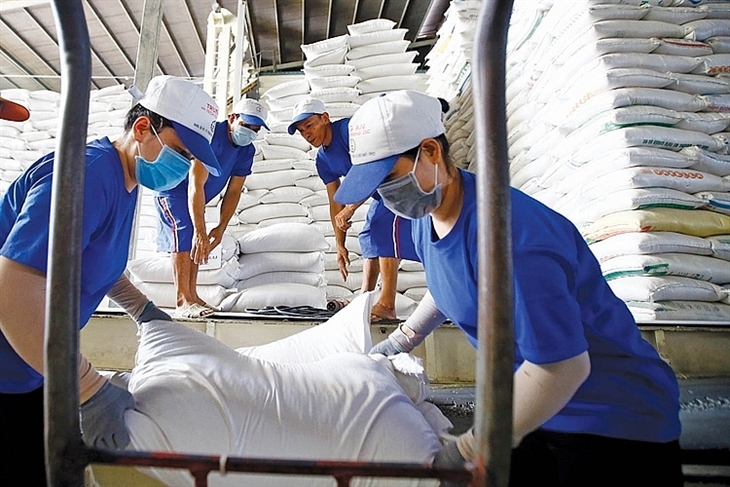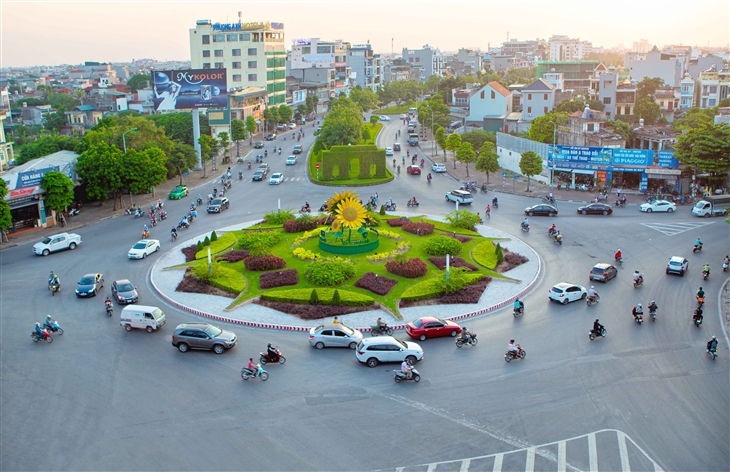China is Vietnam's third largest rice import partner
Saturday, March 16,2024
AsemconnectVietnam - In 2023, China was Vietnam's third largest rice import partner, accounting for about 11% of the country's total rice export volume and turnover.
China accounted for about 11% of Vietnam's total rice exports
According to an announcement by China Customs, in 2023, China imported 2.63 million tonnes of rice, down by 57.5% compared to 2022. In December 2023 alone, China imported 230,000 tons, an increase of 100,000 tons compared to the same period in 2022. Thailand is still China's largest rice supply partner in December 2023.
For many years, China's rice imports have accounted for less than 4% of total domestic rice production. In particular, some types of high quality rice are added to consumption in the high-end rice segment, some common types of rice are used to mix with local rice types or are processed and packaged under brand of Chinese enterprises. In addition, low-grade rice and broken rice are used in processing industry (starch production, wine production) and animal feed industry.
According to statistics from General Department of Vietnam Customs, in 2023, China was Vietnam's third largest rice import partner (down 1 place compared to 2022 and behind the Philippines and Indonesia), accounting for about 11% of total rice export volume and turnover of the country.
Accordingly, Vietnam has exported 917,255 tonnes with a turnover of about 530.6 million USD (average price 578 USD/ton; slightly higher than two partners ranked above with 559 USD and 549 USD/tonne).
Update market information, seize opportunities to export
During a period of 2017 - 2022, China's rice imports from Vietnam recorded relatively large fluctuations. If in 2017, China imported up to 1 billion USD of Vietnamese rice products, by 2019, import turnover reached just over 240 million USD and recovered again in a period of 2020 and 2021 and tends to decreased in the past two years.
According to Commercial Counselor in China, every year, China issues import quotas for rice. In 2023, the country's rice import quota was at 5.32 million tonne, of which the quota is for long-grain rice with 2.66 million tonnes and short-grain rice with 2.66 million tonnes. This number has not changed in recent years.
Currently, China only allows 21 Vietnamese enterprises to export rice to this market (out of a total of about 200 licensed enterprises).
Currently, rice products available on the Chinese market are relatively high quality, besides exporting countries pay great attention to packaging.
Through work of understanding situation, Vietnam Trade Office in Beijing found that rice packaging from Thailand and Laos in Chinese supermarket systems (even supermarket systems in Northern China - area that is relatively strict in terms of product quality and packaging requirements) is packaged very firmly, eye-catching and suitable to the tastes of Chinese consumers. This means that Vietnamese rice is facing fierce competition in Chinese market.
Notably, since the conflict between Russia and Ukraine broke out, there have been many fluctuations in global food supplies, so China's food import structure has also been affected.
In 2024, it is likely that China continue to increase rice imports to harmonize import and production to ensure food security. It is forecasted that import capacity will increase due to the need for animal feed production. Domestic farming remains at a high level.
With India recently issuing a policy banning rice exports, although Chinese Central government has not issued any specific policy response, business community operating in Chinese food sector have begun to make moves to find alternative sources of supply.
With China having an import quota and supply shrinking, prices are expected to increase in the near future. It cannot be ruled out that there will be massive purchasing from some importers in Vietnam. In recent days, a number of Chinese importers have contacted and sought partners who are allowed to export Vietnamese rice.
Regarding imported broken rice (one of the main replacement products for corn and wheat used in the animal feed industry), according to experts in this country, with India having issued a ban on rice export, so broken import volume from these partners is forecast to decrease compared to the previous two years (2022 and 2023) and China will increase imports from other partners including Vietnam.
Vietnam has ability to supply popular rice lines in China (such as high-quality fragrant rice, ST rice, sticky rice, etc.) and has established long-term traditional customer relationships.
Vietnam's rice export businesses always recognize that China is an important market, ranking third among Vietnam's rice import markets, and have continuously strived to improve product quality and specifications, meet regulations well and serve needs and tastes of Chinese consumers.
However, Mr. Nong Duc Lai - Commercial Counselor in China noted that Vietnamese rice exporting enterprises need to further update market information and seize opportunities to export. At the same time, it is necessary to diversify trade promotion activities, penetrate into potential areas of your country to expand exports as well as focus on building a rice brand in this billion-people market.
Source: Vitic/ congthuong.vn
According to an announcement by China Customs, in 2023, China imported 2.63 million tonnes of rice, down by 57.5% compared to 2022. In December 2023 alone, China imported 230,000 tons, an increase of 100,000 tons compared to the same period in 2022. Thailand is still China's largest rice supply partner in December 2023.
For many years, China's rice imports have accounted for less than 4% of total domestic rice production. In particular, some types of high quality rice are added to consumption in the high-end rice segment, some common types of rice are used to mix with local rice types or are processed and packaged under brand of Chinese enterprises. In addition, low-grade rice and broken rice are used in processing industry (starch production, wine production) and animal feed industry.
According to statistics from General Department of Vietnam Customs, in 2023, China was Vietnam's third largest rice import partner (down 1 place compared to 2022 and behind the Philippines and Indonesia), accounting for about 11% of total rice export volume and turnover of the country.
Accordingly, Vietnam has exported 917,255 tonnes with a turnover of about 530.6 million USD (average price 578 USD/ton; slightly higher than two partners ranked above with 559 USD and 549 USD/tonne).
Update market information, seize opportunities to export
During a period of 2017 - 2022, China's rice imports from Vietnam recorded relatively large fluctuations. If in 2017, China imported up to 1 billion USD of Vietnamese rice products, by 2019, import turnover reached just over 240 million USD and recovered again in a period of 2020 and 2021 and tends to decreased in the past two years.
According to Commercial Counselor in China, every year, China issues import quotas for rice. In 2023, the country's rice import quota was at 5.32 million tonne, of which the quota is for long-grain rice with 2.66 million tonnes and short-grain rice with 2.66 million tonnes. This number has not changed in recent years.
Currently, China only allows 21 Vietnamese enterprises to export rice to this market (out of a total of about 200 licensed enterprises).
Currently, rice products available on the Chinese market are relatively high quality, besides exporting countries pay great attention to packaging.
Through work of understanding situation, Vietnam Trade Office in Beijing found that rice packaging from Thailand and Laos in Chinese supermarket systems (even supermarket systems in Northern China - area that is relatively strict in terms of product quality and packaging requirements) is packaged very firmly, eye-catching and suitable to the tastes of Chinese consumers. This means that Vietnamese rice is facing fierce competition in Chinese market.
Notably, since the conflict between Russia and Ukraine broke out, there have been many fluctuations in global food supplies, so China's food import structure has also been affected.
In 2024, it is likely that China continue to increase rice imports to harmonize import and production to ensure food security. It is forecasted that import capacity will increase due to the need for animal feed production. Domestic farming remains at a high level.
With India recently issuing a policy banning rice exports, although Chinese Central government has not issued any specific policy response, business community operating in Chinese food sector have begun to make moves to find alternative sources of supply.
With China having an import quota and supply shrinking, prices are expected to increase in the near future. It cannot be ruled out that there will be massive purchasing from some importers in Vietnam. In recent days, a number of Chinese importers have contacted and sought partners who are allowed to export Vietnamese rice.
Regarding imported broken rice (one of the main replacement products for corn and wheat used in the animal feed industry), according to experts in this country, with India having issued a ban on rice export, so broken import volume from these partners is forecast to decrease compared to the previous two years (2022 and 2023) and China will increase imports from other partners including Vietnam.
Vietnam has ability to supply popular rice lines in China (such as high-quality fragrant rice, ST rice, sticky rice, etc.) and has established long-term traditional customer relationships.
Vietnam's rice export businesses always recognize that China is an important market, ranking third among Vietnam's rice import markets, and have continuously strived to improve product quality and specifications, meet regulations well and serve needs and tastes of Chinese consumers.
However, Mr. Nong Duc Lai - Commercial Counselor in China noted that Vietnamese rice exporting enterprises need to further update market information and seize opportunities to export. At the same time, it is necessary to diversify trade promotion activities, penetrate into potential areas of your country to expand exports as well as focus on building a rice brand in this billion-people market.
Source: Vitic/ congthuong.vn
Solutions proposed to improve investment environment in HCM City
Expanding markets, fruit and vegetable exports continue to increase
DAILY: Vietnamese pepper prices rose by 500 VND on March 15, 2024
DAILY: Vietnamese coffee prices increased by 100 VND on March 15, 2024
Which product had the strongest growth of export turnover in February, earning more than 200 million USD?
China is Vietnam's largest wood chip export market
In the first 2 months of this year, textile fiber exports earned more than 666 million USD
Bright economic spots at beginning of the year
Expanded land use rights expected to attract OV investment in real estate
PM urges enhancing credit access, absorption to fuel growth
In 2023: Wood pellet export earned nearly 680 million USD
DAILY: Vietnamese pepper prices fell by 1000 VND on March 14, 2024
DAILY: Vietnamese coffee prices decreased by 100 VND on March 14, 2024
Industrial production continued to show positive signs

Plan of Hai Duong province for a period of 2021 - 2030, ...
Organize space reasonably and harmoniously, focusing on connecting Hai Duong in common development space, actively contributing to the ...Plan of Hau Giang province in a period of 2021 - 2030, ...
Sustainable forestry development program in a period of ...
Supporting industry development program in Da Nang city in ...
Implementation plan of Scheme on promoting agricultural, ...

Hanoi harnesses “soft power” of culture in development
Since joining the UNESCO Creative Cities Network in the “Design” category in 2019, Hanoi has organised a multitude of activities relating ..."Happy Tet 2024" to open in Hanoi
Vietnamese literary works served up at Brussels restaurant



